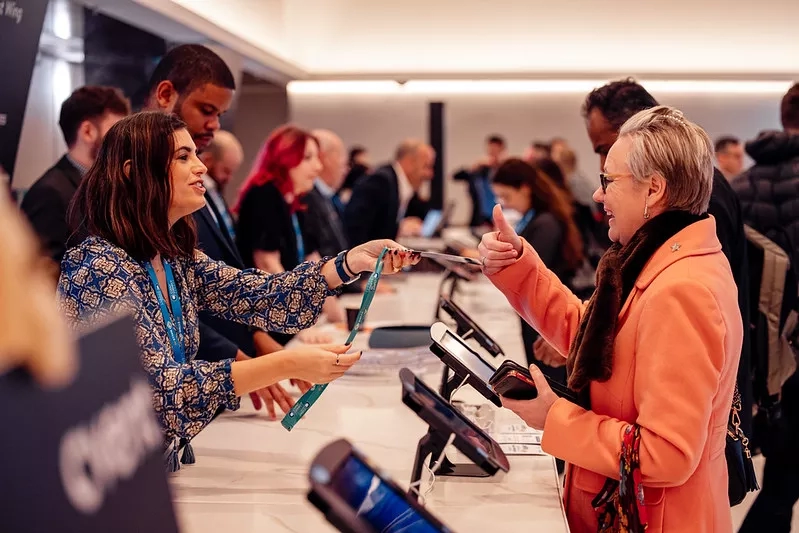The accelerated use of technology in events has had a dramatic impact on audience engagement. With technology, you can better understand your attendees, what they care about, and how to shape exceptional experiences that really spark their interest and participation.
However, with so many different touchpoints, channels and technology options, how can you be sure you’re maximising audience engagement at every stage of your events?
Read on as we explain why engagement matters and provide 19 audience engagement tips for before, during and long after your event has ended. They’ll help you to build a constantly engaged community that will have a major say in the success of your events for a long time to come.
What is audience engagement?
Audience engagement refers to your event’s ability to hold the attention of its attendees while encouraging active participation with your content.
Engaged audiences will ask questions, participate in live polling, provide survey feedback, and embrace all those opportunities you offer to network, learn and develop their knowledge.
Your event app will be a key attendee engagement tool, so make sure it is set up to send out push notifications and it has features such as gamification, surveys, polls, matchmaking and other drivers of engagement.
Why is audience engagement important?
Your audience engagement could mean the difference between a popular sellout event or a no-show flop.
High levels of engagement drive attendance, rebooks, word-of-mouth advocacy, sponsorship, a sense of community and delegate satisfaction.
Essentially, if your audience is engaged, it proves you understand their wants and needs and that you’re delivering compelling experiences that satisfy their objectives for attending.
In short, attendee engagement is measured by how much your attendees actively participate in and gain something from your event programme. It will give you data-backed insights to better tailor your content to your audience, plus the proof of ROI required to justify the outlay from both sponsors and stakeholders.
{"preview_thumbnail":"/sites/default/files/styles/video_embed_wysiwyg_preview/public/video_thumbnails/ijbTEoaUioU.jpg?itok=36QeW-qM","video_url":"https://youtu.be/ijbTEoaUioU?feature=shared","settings":{"responsive":true,"width":"854","height":"480","autoplay":true},"settings_summary":["Embedded Video (Responsive, autoplaying)."]}
19 tips to increase audience engagement
Before the event
Pre-event engagement is about creating interest, intrigue and excitement around your content programme and giving people more reasons to register and begin their experience. At this stage, you have a great opportunity to find out more about your audience and create deeper connections.
- Be part of the conversation
Engage with conversations online about your event and listen to what people are saying about the experience of attending. Are these conversations already giving you new ways to improve their engagement? What topics are they discussing and how can you use these social chats to develop your content offer? Compare what your audience says online to event feedback surveys from previous years. It will give you a clearer picture of developed trends and audience expectations.
2. Coordinate a countdown
Create a countdown campaign via email and social media channels, which runs as the registration deadline approaches. FOMO, or the Fear of Missing Out is a powerful motivator to get people onto your registration website and to download your event app.
3. Create compelling content
Create marketing content that outlines the benefits that attendees will gain from the event. This could be teaser videos, speaker announcements, blog articles or audience testimonials.
Always include a call to action in your copy to encourage engagement and publish via a broad range of channels such as social, email, your event app and industry media.
4. Run polls and surveys
A simple way to assess what your audience wants is to ask them. Consider polling registrants about the kind and type of content they’d like to see, whether that’s at the point of registration or before your event sessions are locked in place.
5. Stay focused on event communications
Make it easy for registrants and potential attendees to communicate with you. Respond to questions on social media, send regular email reminders, and make it easy for attendees to sign up for both email and SMS updates. Send pre-event push notifications via your event app to encourage people to plan their schedule, request meetings and engage with your content.
6. Spark excitement when people register
Make sure your event website has all the latest information, is showing up in Search and is easy to navigate. Once people have filled out your registration form, make it easy for them to download their badge, book accommodation and transport, and spread the word by giving them visuals to post on social media telling their networks that they’ll be attending.
During the event
Audience engagement during your event is about keeping energy and participation levels high while ensuring consistent and compelling communications.
7. Mix up seating arrangements
Encourage your attendees to get to know one another by adding seating layouts, such as round tables or poser tables that promote conversation and interaction.
8. Manage presentations
To keep your attendees immersed in the event experience, sessions need to be interactive, varied in delivery style and length, and curated to appeal to different interests.
Don’t let your speakers deal out ‘Death by PowerPoint’. Instead, encourage ‘Fireside chats’, audience participation, discussion groups and workshops.
9. Gamify networking and participation
Add gamification features and matchmaking to your event app to encourage networking and engagement. Set up competitions, leaderboards and polls to drive discussions.
Incentivise attendees to go to sessions, explore features, chat with sponsors and engage with your content. Ask your attendees trivia questions about the event, or provide fascinating facts that can be used as ice-breakers to initiate conversations between attendees.
10. Offer content tracks for specific interests
If your attendees have different interests or work in different fields, create content ‘tracks’, or session themes to appeal to specific interest groups. At our annual Cvent CONNECT Europe conference, for instance, we design a stream of content specifically geared towards event planners and another stream of sessions for hospitality professionals.
11. Offer wellness opportunities
Keep attendees moving by breaking up the day with an exercise or yoga class. Or, help decrease stress with meditation or massage stations.
If you’re going virtual, consider a group step challenge that everyone can participate in. Adding wellness opportunities will increase attendee satisfaction and overall engagement.
12. Switch up the way you serve food
Add a touch of theatre during break times by asking chefs to showcase their culinary flair at performance stations and serve food directly to your guests. If you’re serving food while encouraging networking, opt for a reception service or butlered hors d’oeuvres service.
You could, of course, combine different table service styles. Dessert stations, for example, create a visual spectacle, which will encourage your guests to get up from their tables, move around and share this part of their dining experience on social media.
13. Find out how attendees are feeling
A key way to gauge audience engagement levels is to allow attendees to review each of your sessions as soon as they've finished.
Ask your attendees to rate speakers on a scale of one to five, for example, and review content by asking open-ended questions.
In addition to session ratings, polls conducted through your event app allow you to collect on-the-spot data about how an attendee is feeling.
After the event
Audience engagement after your event means keeping the communications going, asking for feedback, growing your communities and providing continued opportunities to engage with your content.
14. Don’t forget to say thank you
A quick email or e-newsletter to thank your audience for coming along to your event will leave a lasting impression by making attendees feel valued and appreciated.
Consider thanking your speakers by sending them a small, sustainable gift such as a reusable coffee flask or plant.
15. Show that you care about the attendee experience
Asking post-event survey questions shows you care about your attendees’ event experience and value their opinions. It also shows that you’re prepared to take all feedback (good and bad) on board to provide a better experience for future events.
Advancements in survey software allow you to automate survey creation and personalise questions for different audience personas, such as sponsors, delegates or exhibitors.
By asking better questions across different audience segments, you’ll get deeper insights that you can compare with previous years. Use them to predict behaviours and trends, develop content, and gain a deeper understanding of your attendees.
16. Make sessions available on demand
With technology, your event can live on beyond its official end date. Provide access to those sessions your audience may have missed by filming them and then making the video available on-demand via your event platform.
17. Develop a year-round content plan
Keep your audience engagement going by developing a year-round content strategy that will grow an active community and ensure people return to your event time and again.
Work with your marketing team to repurpose and edit on-demand session videos for different social channels. Create exclusive new content that will entice and excite your audience.
You could film backstage interviews with speakers or provide follow-up learnings on a particular topic. You could create online discussion groups, webinars, key highlights, information about upcoming events and more.
18. Launch a marketing campaign for your next event
Send an exclusive discount for your next event to recent attendees only. Show your appreciation for their participation, build brand loyalty, and get audiences excited about what’s coming next.
19. Encourage social sharing
Encourage your attendees to share their photos and videos of your event across social media.
You could launch a competition for the best memorable moments. Or, why not create a post-event hashtag for your audience to use so that they can see what other people have posted and you can easily view and track their post-event engagement?
How to measure event engagement
You can measure audience engagement by analysing and combining data and feedback from the following areas:
- Registration and attendance rates
- Session registrations
- Event app downloads
- Session engagement
- Event app engagement
- Gamification leaderboards
- The number of matchmaking appointments
- Live polling response rates
- Live survey feedback
- Post-event feedback surveys
- Social media coverage
Make sure you have analytics set up within your event management software. You’ll need to track how your audience engaged with the registration website, how they engaged with your event app and how they used the technology on offer to engage with your overall event experience.
Best practices for increasing audience engagement
As discussed in this article, get to know your audience and start building a community around your event so that you tailor content and deploy engagement tools that offer the best ROI.
Leverage your event app to drive engagement, boost participation, communicate effectively and evaluate your event’s performance.
Assess where you can add or improve engagement tactics before, during and after your event. And keep your audience engaged with a year-round content offer and regular communication.
To learn more engagement strategies and best practices you can implement at your next event, read our Ultimate Guide to In-person Events.







